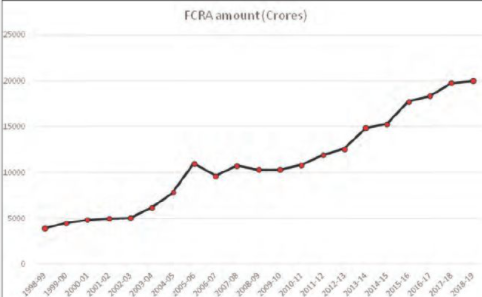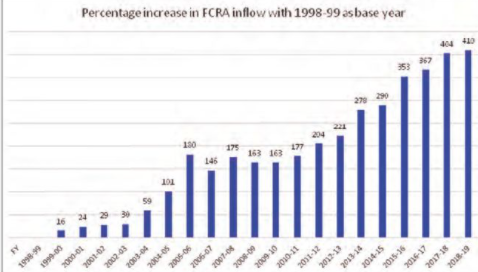A fruitful NGO-government partnership in India is a distant goal, but several significant steps have been taken towards it
-Vikram K Malkani

Popular perception is thatnon-governmental or voluntary organisations (NGOs/VOs) are organisationshaving social or humanitarian agendas,and are funded in their noble missions by philanthropists and other individual and institutional donors. NGO uniting platforms such as WANGO and INSO reinforce these perceptions with lofty declarationsof serving humanity and promoting world peace. In an ideal world, every NGOshould providesome form of social or humanitarian support to individuals and sections of society where governments may not be able to reach.India’s population size combined with finite resources with governments gives individuals and NGOs unlimited opportunitiesto promote such initiatives.
So, how many NGOs does India really have?
In 2013, triggered by a Public Interest Litigationseeking transparency in finances of an NGO run by social activist Anna Hazare, the Supreme Courtasked the Central Bureau of Investigation (CBI) to identify all registered NGOs and statuses of filing of their balance sheets. CBI declared the number of NGOs in Indiato bea staggering 31 lakhs. Of theseonly 99125 were self-declared in NGO Darpan, a NITI Aayog platform that “provides space for interface between VOs/NGOs and key Government Ministries / Departments / Government Bodies”.
It is worth noting that NGOs and VOs can be registered in India under a variety of acts, such as Indian Societies Registration Act (1861), Religious Endowments Act (1863), Trusts Act and Section 8 of the Companies Act.The 31 lakh NGOs identified by CBI were only the ones registered under Indian Societies Registration Act. So, the number includes all societies, including organisationsnot performing conventional NGO activities, and does not include NGOs registered under the other applicable acts. In addition, the exercise is five years old. So one cannot at all be certain of even the approximate number of NGOs in India having social agendas. A listing of NGOs/VOs operating in India could not be found in Union government sites. So there are several unanswered questions – how many real NGOs/VOs does India have? How many of them are Indian, how many non-Indian? And very importantly – What is the agenda of each? Who are their promoters and their donors?
In the world’s largest democracy with literally countless NGOs operating across the country, it is critical that Union and state governments are aware of the number of real NGOs operating, their declared agendas, having oversight on their activities, sources of funding, financial spend,as well as their key appointments.
Undoubtedly, this will be a colossal exercise requiring greater clarity to be introduced in the law itself, then filtering social, religious and political NGOs from all registered non-profit organisations, and finally,ensuring governance of them.
Because of the longstandinglack of legal clarity on definition of NGOs, another interesting aspect about them isn’t know yet – how many have registered in India over the last 25-30 years, and whether thenumberscan be related to the national governments in power at the time of their registration.
In addition to seeking answers on NGOs, it’s worth exploring one more dimension– the amount of funding they have been receiving, and its sources.Given the ambiguity around definition of NGOs, the amounts or percentage contributions by Indian and foreign donors will not be easy to figure out. However, some information on foreign funds sent to NGOs in India is publicly available. Based onForeign ‘Donations’, With Hidden Agenda, Are Serious Danger To India’s National Security (Outlook,28-Jan-20), and inputs from GoI, below are graphical representations of amount of foreign fundingthat has flowed into India to NGOs from 1998-99 till 2018-19 – a period that spanned Union governments under National Democratic Alliance and United Progressive Alliance.
From ₹3295 crores in 1998-99, NGOs/VOs received ₹20011 crores in 2018-19. In percentage terms, with 1998-99 as base year, there was an increase of over 400% in the last two years of this period. Apart from three years during this period, the inflow has always been higher than in the preceding years. The biggest jump in foreign funding during this period happened in 2005-06, the first year of the Indian National Congress-led United Progressive Alliance (UPA) being in power. There was another steep one in 2015-16, a year after the Narendra Modi led National Democratic Alliance (NDA) came to power.
According to the same article, on 01-Apr-17 the total foreign origin funds brought forward by the NGOs were ₹15,907 crores. Meanwhile, an amount greater than that brough forward – ₹19,764 crores– was further pumped into India in the year 2017-18. Since when did money become this cheap?
According to CBI in 2015, only 10% NGOs were filing their balance sheets. NDA cracked the whipby cancelled FCRA licenses of approximately 14,500, and the registration altogether of over 1800 NGOs for non-submission of returns in 2017-18
Further, more than 50% of the amount brought forward on 01-Apr-17 is concentrated in the hands of about 2% of the NGOs that receive foreign funds. As if all this is not fishy enough, of the 22,39,971 NGOs in 20 states examined by CBI up till 2015, less than 10% (2,23,428) had filed balance sheets with the authorities (‘It’s Raining NGOs in India, 31 Lakhs and counting’, LatestLaw.com, 01-Aug-15).

To sum up the situation, India has an unusuallylarge number of NGOs with their categorizations not being clear, a very small percentage of NGOs are attracting huge amounts of sustained foreign funding, those NGOs are hoarding large amountsof money but still attracting funds year after year, over 90% of the ones investigated weren’t filing balance sheets, and only a tiny fraction have registered in NGO Darpan.
Clearly, such a situation that would make any government suspicious.
What exactly are the wealthy NGOs doing?
For sure, many NGOs in India are fulfilling the purpose for which they are created – feeding the hungry, providing education to children, supporting enterprising women to become financially independent, rehabilitating those affected by natural calamities, and so on.
But what are some others up to? Here are some insights.
In 2012 in a rare display of assertiveness (only just, but welcome nevertheless), the then Prime Minister of India, Dr Manmohan Singh had accused NGOs funded by United States and Scandinavian countries of disrupting India’s development objectives, specifically, pursuingnuclear power and genetically modified crops.Based onan Intelligence Bureau (IB) report, the UPA govt had gone a step further andaccusedcertain NGOs of indulging in antinational and political activities.The stand taken by UPA came none too soon. According to UPA’s Environment Minister, Jayanthi Natarajan, certain NGOs had penetrated the highest levels of decision making in her ministry. INC has a history of warmth towardsNGOs. Ford Foundation was illegally accommodated in India soon after Independence by no less than India’s first Prime Minister (Ford Foundation an entity outside law. The Sunday Guardian, 06-Jun-15).And two political generations on, an extra-constitutional body National Advisory Committee, which “advised” the UPA govt, was established. Headed by UPA Chairperson Sonia Gandhi, it had people linked with NGOs as its members.
UPA seems to have done little more than order the investigation and subsequently protest publicly during the last two years of its rule.In spite of Jayanthi Natarajan’s statement, there were no media reports of a cleanup of her ministry (or any other, if those too had been compromised). Another area UPA seemed to be unwilling to challenge was religious conversions by some foreign money funded NGOs. To be clear, only a handful of Indian states have laws against conversions. So technically, organisations can promote conversions in other states. However, according to the Foreign Contribution (Regulation) Act 2010, there are restrictions on acceptance of foreign funds for religious conversions.
What has the NDA govt done?
The IB report was submitted to Prime Minister Narendra Modi soon after he assumed office in 2014. Credit must go to the NDA for taking decisive action against wayward NGOs. According to CBI in 2015, only 10% NGOs were filing their balance sheets. NDA cracked the whipby cancelled FCRA licenses of approximately 14,500, and the registration altogether of over 1800 NGOs for non-submission of returns in 2017-18.
Multiple India-based entities under Amnesty International have landed into trouble with GoI over several FCRA violations. Amnesty International was accused of violating FCRA in Nov-19 and its offices were raided by CBI. Last week AA closed down its operations in India, while claiming that GoI was on a witch hunt.
The crackdown in general has led to aggressive attemptsto show the violative NGOs as victims and the usual performances by the usual actors on social media.If indeed GoI agencies have fabricated violations in spite of accounts showing compliance to FCRA, what stops AA or any other NGO from approaching the Supreme Court? Why are they not grabbing this golden opportunity to prove their longstanding charges of fascism against the Narendra Modi-led govt?
On NGOs promoting religious conversions NDA has taken the bull by its horns. In 2016 it barred an institutional American donor from funding religious conversions via a Tamil Nadu-based NGO. In Sep-20 it suspended the foreign funding licenses of 13 NGOs, allegedly over conversions, in violation of FCRA 2010. This stand hashad the expected backlash.Two US government-sponsored reports have taken strong exception to the FCRA and anti-conversion laws being misused to “undermine” religious freedom. Consider a hypothetical situation of some Hindu organisations setting up branches in democracies having non-Hindu majorities, receiving considerable sustained funding from Hindu temple trusts, even from GoI, and converting non-Hindus while possibly disguising their agenda with social initiative. Will such an arrangement have governmental support in those democracies?
In addition to actions against illegalities of various NGOs including high profile ones, the Union govt has also introduced reforms. The FCRA Amendment Bill 2020 mandates declaration of Aadhaar for each office bearer of an NGO, prohibits public servants from receiving any foreign funding, prohibits transfer of received foreign funds to another association/person. So far NGOs have had allowance to budget up to 50% of their funds as administrative expenses. According to the 2020 amendment, this has been capped at 20%, aligning NGOs more closely with their noble missions than being about lucrative careers. It also aligns with sentiments of genuine donors, who would rather pay for meals or education of underprivileged children’s than for business class travel of executives of NGOs.

Earlier amendments to FCRA by NDA have included all members of NGOs seeking foreign contribution to declare that they have not been “prosecuted or convicted” for “conversion” from one faith to another and for creating “communal tension and disharmony” and made it mandatory for all non-governmental organisations that receive or hope to receive foreign funding to register with NGO Darpan. Although passed by Parliament, the 2020 amendment bill too was met with trademark opposition by INC and others on various provisions.
What more should GoI do?
The NDA govt has undoubtedly taken a series of bold steps to get a clearer picture on NGOs versus non-NGOs in India, increase transparency in NGOs’ funding and activities, channel greater amount of donors’ money towards social and humanitarian causes, and improve governance over compliance to FCRA and other applicable laws. Clearly, these were long overdue. Governments in India may never have sufficient resources to provide for fundamental needs of all individuals andsociety. This makes the role of genuine NGOs critical in extending govt initiatives, and evolving their own. A fruitful NGO-government partnership in India is a distant goal, but several significant steps have been taken towards it.
(The writer is a Bengaluru based independent commentator)














Comments